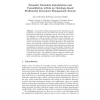ESWS
2008
Springer
14 years 2 months ago
2008
Springer
Finding RDF individuals that refer to the same real-world entities but have different URIs is necessary for the efficient use of data across sources. The requirements for such inst...
ESWS
2008
Springer
14 years 2 months ago
2008
Springer
Abstract. Geographic place names are semantically often highly ambiguous. For example, there are 491 places in Finland sharing the same name "Isosaari" (great island) tha...
ESWS
2008
Springer
14 years 2 months ago
2008
Springer
In this paper, we examine the special requirements of lifecycle management for entities in the context of an entity management system for the semantic web. We study the requirement...
ESWS
2008
Springer
14 years 2 months ago
2008
Springer
Abstract. The Semantic Web is an effort by the W3C to enable integration and sharing of information across different applications and organizations using annotations by means of on...
ESWS
2008
Springer
14 years 2 months ago
2008
Springer
Abstract. Automated modeling of appropriate and valid document descriptions is a central issue for the benefit and success of an ontologybased personal document management system. ...
ESWS
2008
Springer
14 years 2 months ago
2008
Springer
Many tasks on the semantic web require the user to choose concepts from a limited vocabulary e.g. for describing an indexed resource or for use in semantic search. Semantic autocom...
ESWS
2008
Springer
14 years 2 months ago
2008
Springer
Both Topic Maps and RDF are popular semantic web standards designed for machine processing of web documents. Since these representations were originally created for different purpo...
ESWS
2008
Springer
14 years 2 months ago
2008
Springer
One of the crucial reasons for adding semantic descriptions to Web services is to enable intelligent discovery, removing the need for a human to manually search and browse textual ...
ESWS
2008
Springer
14 years 2 months ago
2008
Springer
We present SHIRI-Annot an automatic ontology-driven and unsupervised approach for the semantic annotation of documents which contain well structured parts and not well structured o...
ESWS
2008
Springer
14 years 2 months ago
2008
Springer
Abstract. Wikipedia, a collaborative Wiki-based encyclopedia, has become a huge phenomenon among Internet users. It covers huge number of concepts of various fields such as Arts, G...



